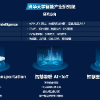Low-cost air pollution sensor networks are increasingly being deployed globally, supplementing sparse regulatory monitoring with localized air quality data. In some areas, like Baltimore, Maryland, there are only few regulatory (reference) devices but multiple low-cost networks. While there are many available methods to calibrate data from each network individually, separate calibration of each network leads to conflicting air quality predictions. We develop a general Bayesian spatial filtering model combining data from multiple networks and reference devices, providing dynamic calibrations (informed by the latest reference data) and unified predictions (combining information from all available sensors) for the entire region. This method accounts for network-specific bias and noise (observation models), as different networks can use different types of sensors, and uses a Gaussian process (state-space model) to capture spatial correlations. We apply the method to calibrate PM$_{2.5}$ data from Baltimore in June and July 2023 -- a period including days of hazardous concentrations due to wildfire smoke. Our method helps mitigate the effects of preferential sampling of one network in Baltimore, results in better predictions and narrower confidence intervals. Our approach can be used to calibrate low-cost air pollution sensor data in Baltimore and any other areas with multiple low-cost networks.
翻译:暂无翻译





